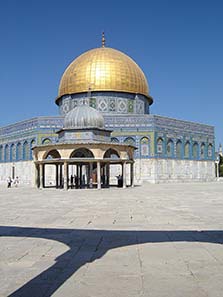The first Islamic gold coin in history
On November 30th, 2010, a remarkable coin will be auctioned off at the auction house Numismatica Genevensis in Geneva. The coin shows in minute detail – it is after all the best preserved example in private ownership – Herakleios with his three sons, but was minted by a confessor to the Islamic faith. Abd al-Malik, ninth Caliph, had this coin produced in 691/2 (72-73 AH).
Herakleios as universal ruler
Surah 18 of the Qur’an tells the story of Dhu-l-Qarnayn. Dhu-l-Qarnayn, that is He of the Two Horns (a reference to the ram’s horns of Ammon), defeated the Gog and Magog peoples. According to Volker Popp in “Der frühe Islam“ (2007) that legendary figure goes back to Alexander the Great, albeit not the historical one from Macedonia but the Byzantine Alexander, hence to Herakleios.
Emperor Herakleios (610-641) was by no means unfamiliar to the Arabs. After all, there was a common enemy to defeat, the Sassanids. Herakleios approached the Arab clans. By selective propaganda, he tried to persuade the local Christians of the universal fight between good and evil in which they assumed their role as Herakleios’ allies. He made good use of the image of Alexander raising shields against the peoples from the deep. In 622, Herakleios achieved a decisive victory over the Sassanids. As a result, the Arab clans gained their autonomy as well.
That the connection between Dhu-l-Qarnayn and Herakleios was not plucked out of the air is testified by a hadith, a legend. The hadith makes clear that it was still common knowledge in the Arab region of the 9th century A. D. that Dhu-l-Qarnayn did not refer to the Macedonian Alexander but to the Byzantine Alexander-Herakleios.
Although all personal connections between Herakleios and the Arab clans got lost when the Byzantine ruler died, many continued to regard that victor over the Sassanids “the” faithful universal ruler who had crushed the worshipper of the fire.
Abd al-Malik bin Marwan, AH 65-86 (685-705), Solidus AH 72-73 (691-692), without specification of the mint (Damascus). Miles, “The earliest Arab gold Coinage” in “Museum Notes” 13 (1967), 10, pl. XLV. From auction sale Numismatica Genevensis 6 (2010), 285.
Heraklius, 610-641, with his sons Heraklius Constantin and Heraklonas, 632-641. Solidus, Constantinople, 636/7. Sear 761. From auction sale Numismatica Genevensis 2 (2002), 181.
Abd al-Malik and Justinian II
Two men assumed rulership of an empire in A. D. 685 (65 AH). The one resided in Constantinople, the other in Damascus. The first was 17 years old, the other 39. One was called Justinian II, the other Abd al-Malik.
Abd al-Malik had come into power after a time of civil war. He was quite aware of the fact that he had to bind his empire together with symbols and a splendid administration. An effective governing of vast areas demanded structures. It was only logical that he utilized Byzantine models. Justininan on his part grappled with worries of a different kind. In 691/2, it was laid down in the Council in Trullo – it got its name after a domed hall in the imperial palace –, that it was hitherto forbidden to depict Christ as Lamb of God. It was required to show him in human guise instead. That led to a change of the Byzantine coin image: the bearded Christ became the motif of the obverse.
Is the production of solidi by Abd al-Malik connected with the change of the images on the Byzantine coins? In any case, the adoption of the full length depiction of Herakleios as the victor over the Sassanids and his sons, in combination with the legend Bism Allah la ilah illa Allah wahdahu Muhammad rasul Allah (In the name of God. There is no god except the One God and Mohammed is the Prophet of God) reflects an entirely different and completely new conception of the world.
Bearing this legend, which is probably the oldest written testimony of the Shahada, the Islamic Creed, this coin from 691/2 (72/3 AH) is an example of the first, as such, Islamic emission of gold coins at all. The depiction of a Byzantine emperor is not a mere imitation at this point. Rather, Abd al-Malik deliberately chose Herakleios as motif. He regarded Herakleios a universal ruler which had freed the Arabs from the suppression of the Persian pharaoh and in whose line he set himself.
Justinian II, 685-695. Solidus, Constantinople, 692-695. Sear 1448. From auction sale Numismatica Genevensis 4 (2006), 291.
Abd al-Malik had the Dome of the Rock in Jerusalem built. Photograph: Orientalist / Wikipedia.
He initiated the building of the Umayyad Mosque in Damascus as well. Photograph: Jerzy Strzelecki / Wikipedia.
The development of the Muslim iconography
In 695, Justinian II was removed from office in the course of a rebellion. Therewith, the reign of the last successor of Herakleios came to an end. Many Arabs saw that as the end of a legal rule over the Byzantine Empire. A vacuum arose in the spiritual leadership, which a representative of the new faith could likewise fill.
Abd al-Malik tried to give his new claim to leadership substance. In A. D. 695 (74 AH), he issued his programmatic gold coin whose obverse is often referred to as “Standing Caliph”. The year 696 witnessed a rebellion. One of its causes was the refusal of the depiction of the human form on coins. Abd al-Malik answered not only with military force, but by changing his religious propaganda as well. From then on, the coins lacked any images. Instead, since A. D. 698 (77 AH) a gold coin, which was based on the Iranian weight standard of the Mithqal, was issued that showed nothing but legends. Coins with figural representations were systematically demonetized to the result that only a few examples of these emissions that are of great interest to the history of religion, have survived.
















